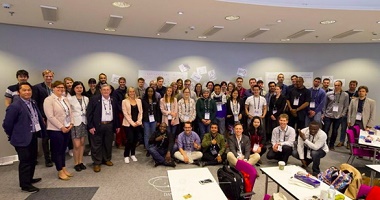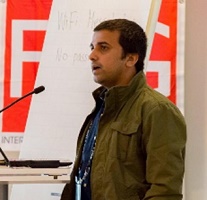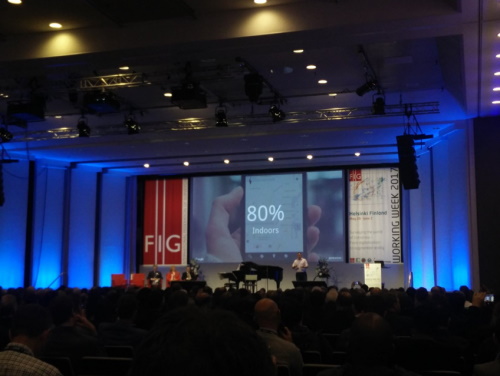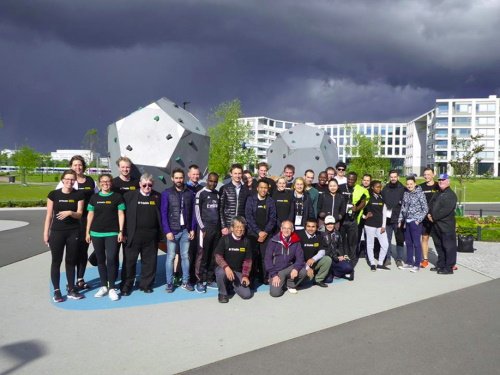FIG Foundation - Building a Sustainable Future

|
Report from Biplov Bhandari
FIG Foundation Young Surveyor Grant Recipient to attend the
FIG Working Week 2017 in Helsinki, Finland
“My belief is that we should never
stop dreaming, and dreams do come true if we have courage to
pursue them, has increased more than ever. I look forward to
contributing more back to Nepal utilizing various technologies
that I learnt at the FIG Working Week.”
For me personally, FIG Working Week 2017 was the
result of desire and continuous effort to attend and
present my work to the larger audience. I started
writing application for Working Week from 2014 during my
undergraduate at Nepal and only got accepted in 2017. To
all the applicants, I request you to follow your passion
and desire and success will come to you. Don’t get sad
if you are not accepted the first time. Remember Rome
was not built in a day. If you really want it, it shall
come to you.
FIG Working Week 2017 was the biggest conference I have attended till
date. So many industry experts, scholars, practitioners and academician to
network with, and so limited time, I think I was little overwhelmed.
Nevertheless, I was able to meet different personality and get to know about
their work more closely.
I attended different sessions during the working week. Working week
started with 5th FIG Young Surveyors European Meeting. As the theme of the
Working Week 2017 was “Surveying the World of Tomorrow - From Digitalisation
to Augmented Reality”, the role of Young Surveyors is very crucial in
determining the direction in which the industry should be moving forward,
especially given that we are at a unique time in history where we have more
information, more computational power to generate knowledge from such
information and integrated disciplines.
It was interesting to know opinion of different personality in this
regard. The presentation from Liisa Kemppainen on Building Information Model
(BIM) for the new Helsinki Airport was a very useful one. The preliminary
concept history of BIM dates back to around 1960’s. At times it was quite a
challenge to prepare the 2D information of the building using CAD models.
There is a major shift in paradigm on how this information are handled. The
modern technology enables us to represent both the physical and intrinsic
properties of a building as an object-oriented model tied to a relational
database. This has changed how surveyors work and think about BIM. I also
got an opportunity to present about the lessons that were learnt from Common
Alerting Protocol (CAP) implementation in Myanmar, Philippines and Maldives.
 |
 |
I am always fascinated by how we can use technology to bring social
impact in the daily lives of people. Keynote speaker Ed Parsons provided a
sneak peek into the future of geospatial technology. He emphasized on how
the world is moving from global to regional to indoor level because 80% of
time we spend indoor. A real time point cloud, a real time classification
for indoor mapping. Now you can imagine the computing power here. He
provided various insights on how future will not see many cars, but people
who will walk, cycle and use public transport. That's very optimistic.

About 1400 participants from more than 90 countries were present at the
Working Week to get closer to what the future brings for surveyors. 10
commissions in FIG got more than 400 papers presented in 57 sessions. So, it
was quite hard to attend all the sessions that interested me. I learnt about
prioritizing the topics according to area of interest and attend them. I was
also author of a paper on the CAP project on alerting and warnings for the
Government of Myanmar, Maldives and Philippines, where I focused on what
technologies we developed to provide information on such a delicate issue
and talked about different challenges working with Bureaucratic procedure of
the country, and various techniques that were implemented to address some of
them.
Also, at FIG Working Week, I got opportunity to take training on
UN-Habitat/GLTN STDM tool. Through this training, Eva Maria Unger and team
provided me opportunity to contribute back to Nepal through Volunteer
Community Surveyor Program (VCSP). GLTN/Kadaster has a STDM project in Nepal
for which I was able to volunteer and contribute back my knowledge to the
team. That is a great feeling. I also helped in the knowledge transfer and
share the coordinate transformation idea of the WGS to local coordinate
system in Nepal. This helped me earned co-author in a paper for FIG Working
Week 2018 as well.
Besides work, the Working Week was a lot of fun and networking. This was
my first time in Europe. The welcome reception was held at the beautiful
Helsinki City Hall, which provided taste of local food at Finland. During
the Gala Dinner John Hohol and the FIG Foundation team provided me some
insights on how simple and welcoming great personalities are. John was kind
enough to share some of his experiences with us. Participating in FIG
Charity Run / Walk was another proud moment to contribute something back to
FIG and OSM community. Luckily, I had some relatives in Finland. I had
chance to meet and experience their lifestyle from very close.

In a nutshell, FIG Working Week has become a milestone for my personal
and professional development. I am very grateful to FIG Foundation for
providing me with the travel grant, for my relatives at Helsinki for making
me feel at home. I have, through this Working Week, realized how small the
Earth is, and how significant it is to network and collaborate. My belief is
that we should never stop dreaming, and dreams do come true if we have
courage to pursue them, has increased more than ever. I look forward to
contributing more back to Nepal utilizing various technologies that I learnt
at the FIG Working Week.
/Biplov Bhandari
Nepal
|



























